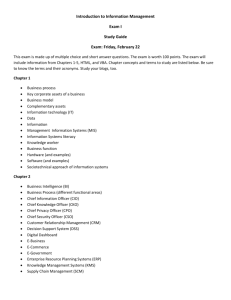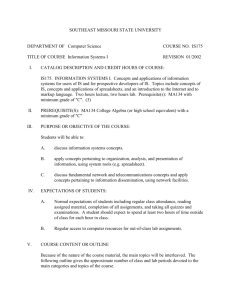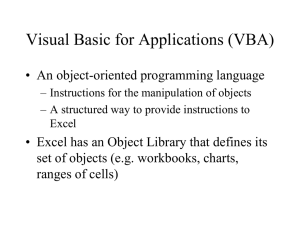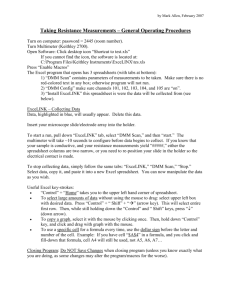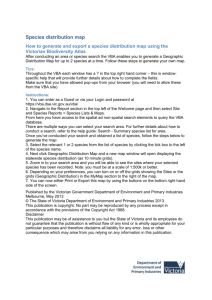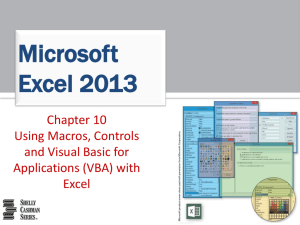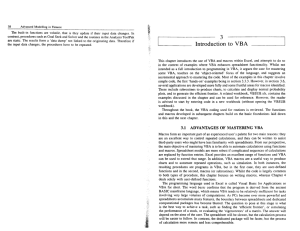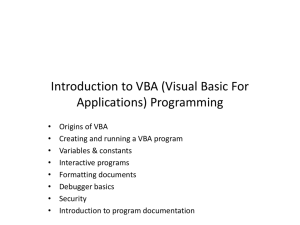Toronto Overheads Ja..
advertisement
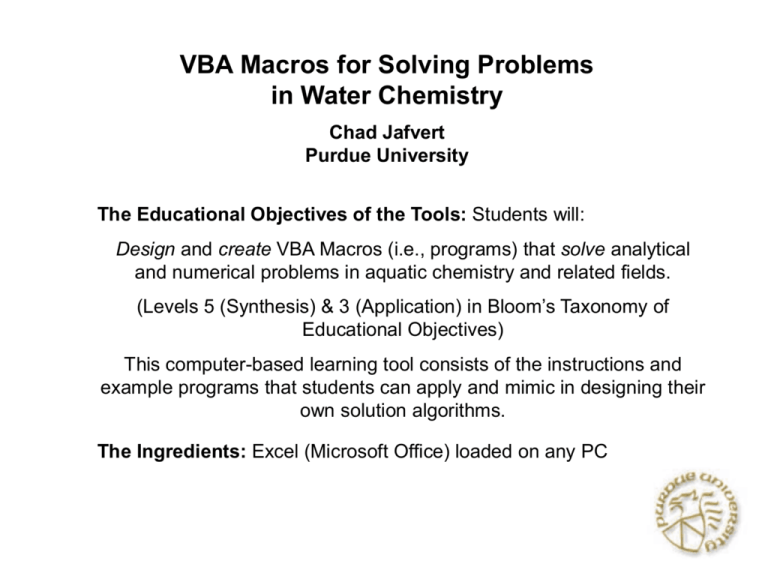
VBA Macros for Solving Problems in Water Chemistry Chad Jafvert Purdue University The Educational Objectives of the Tools: Students will: Design and create VBA Macros (i.e., programs) that solve analytical and numerical problems in aquatic chemistry and related fields. (Levels 5 (Synthesis) & 3 (Application) in Bloom’s Taxonomy of Educational Objectives) This computer-based learning tool consists of the instructions and example programs that students can apply and mimic in designing their own solution algorithms. The Ingredients: Excel (Microsoft Office) loaded on any PC Development Time: ? Development Time (for students): 1 to 2 50-min lectures to convey the tools to the students, 5 min to 40 hrs for students to write a successful VBA macro. Educational Outcomes: The computer skills, program language backgrounds, and programming phobias of students entering graduate environmental engineering and science programs are wideranging, yet these students always have in common the ability to perform mathematical operations in spreadsheets like Excel. With very little additional instruction, they are using VBA in Excel as a programming language and solving rather complex mathematical problems with software they are comfortable with, that is ubiquitous in nature (including on their own PCs), and that has immediate graphical output. Web Address where Instructions and Examples can be Downloaded: http://bridge.ecn.purdue.edu/~jafvert/Macros.html Downloads (demos): Instructions: An Acrobat file contains the instructions for writing VBA macros in Excel and further explanations on each of the sample spreadsheets below. (15 pages) Introduction to VBA.xls: An Excel spreadsheet that contains an example VBA macro that shows how to: (i) dimension variables and arrays, (ii) write 'For . . . Next‘ loops, (iii) read and write to the spreadsheet, (iv) format common mathematical expressions, (v) etc. Functions.xls: A simple spreadsheet than contains some user-defined functions (volume of a cylinder, roots to the quadratic equation, and the sin of an angle measured in degrees). pKa.xls: A spreadsheet that calculates buffer composition and draws the pC-pH diagram of a simple acid. Downloads (cont.) Case 3 p60 in Morel & Hering.xls: A spreadsheet that solves a system of three equations and three unknowns by Newton-Raphson iterations. The 'recipe' for the problem is the same as 'Case 3' on page 60-63 in the text "Principles and Applications of Aquatic Chemistry" by Morel and Hering. Stratified Lake.xls: A spreadsheet that solves a system of 2 simultaneous ODE's with Euler's method. The example case is the transport of TCE in a stratified lake - presented on pages 551-574 in "Environmental Organic Chemistry" by Schwarzenbach, et al. The 2 ODE's are eqs 15-30a and 15-30b (p. 569) in the text. 1D Diffusion.xls: The central difference solution to the 1-D diffusion equation with an impulse input at the center of the media. The numerical solution is calculated with a VBA macro and is compared to the analytical solution calculated directly on the spreadsheet. A second macro calculates the mass under the concentration profile with Simpson's Method. A Very Simple Example VBA program that reads and writes: In Excel, Type ‘3’ in cell B4, then click on ‘Tools’, ‘Macro’, ‘Macros’. Provide a name for your macro, click on ‘create’ Type the following lines and click on ‘Run’, ‘Run Sub’: Now you are ready to solve 3 simultaneous equations: f1 (H , CO32 , A ) f2 (H [H ][CO32 ] Kw' 0 2 [CO32 ] [A ] [H ] 2 CT,Ca 2 ' [H ] Ka,2 , CO32 , A ) f3 (H 0 , CO32 , A ) [H ] 2 [CO32 ] Ka' ,1 0 K a' ,2 [H ][CO32 ] [H ][A ] K a' Ka' ,2 [CO32 ] CT ,CO 2 3 [A ] CT ,A By finding the roots with the Newton-Raphson method: x1 x2 x 3 i1 x1 x2 x 3 i f1 x1 f2 x1 f 3 x1 f1 x2 f2 x2 f3 x2 1 f1 f1 x3 f2 f2 x3 f3 f 3 x3 i i First, solve for the functions and the partial derivatives with initial guesses, invert the matrix, and do the math to solve for the new guesses, all on the spreadsheet. Next, replace the old guesses with the new guesses with a simple ‘read and write’ VBA program. Repeat (iterate) until the problem converges.
